This week’s theme is bees and pollinators. Our “Growing Minds Day by Day” educational resource lists are designed for families and educators.
We hope these resources will provide you with inspiration. Ready to dive in and get busy as a bee? This week we’re celebrating bees and pollinators!
 Book:
Book:
The Beeman by Laurie Krebs
Kick-off your bee-themed week by reading The Beeman, written by Laurie Krebs and illustrated by Valeria Cis. In Laurie Krebs’s first book, she writes the tale of a loving Grandfather (known around town as the Beeman) passing on wisdom to his young granddaughter about his beloved bees, beekeeping, and, of course, honey. Young readers will enjoy learning about the roles both bees and humans play in the making of the syrupy and sweet treat we all love. Don’t worry if The Beeman isn’t part of your at-home library yet–you can watch a video of The Beeman being read aloud on YouTube.
Looking for more pollinator-themed children’s book ideas? Visit the Growing Minds’s farm to school literature database to browse our curated collection of recommended books on farms, gardens, and cooking. Type “bees” into the search bar to find books that celebrate this week’s theme.
In celebration of National Poetry Month, throughout April we’ll also share a poem each week. Today we’re sharing the poem From Bee to Me from the book Fresh-Picked Poetry: A Day at the Farmer’s Market, written by Michelle Schaub, illustrated by Amy Huntington, and published by Charlesbridge. Find additional activities to go along with Fresh-Picked Poetry in Michelle Schaub’s downloadable Story Hour Kit.
From Bee to Me
By Michelle Schaub
Fields of clover with roaming bees,
nectar collected busily.
Hives abuzz with activity,
combs enclosing sweet mystery.
Keepers’ smoke calms the jamboree,
jars of liquid-gold alchemy.
City,
market,
and (finally)
me.
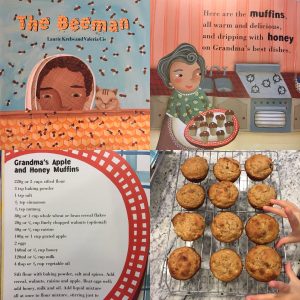
Local Food Recipe:
After reading The Beeman, get your young cooks involved in baking Grandma’s Apple and Honey Muffins from the book. Depending on their age, kids can help with grating the apples using a box grater, measuring and mixing the wet and dry ingredients, and filling the muffin cups.
Grandma’s Apple and Honey Muffins, from the The Beeman by Laurie Krebs
Makes 18 muffins
Ingredients:
- 220 g or 2 cups sifted flour
- 3 tsp baking powder
- 1 tsp salt
- ½ tsp cinnamon
- ¼ tsp nutmeg
- 80g or 1 cup whole wheat or bran cereal flakes
- 20 g or ¼ cup finely chopped walnuts (optional)
- 40 g or ½ cup raisins
- 100 g or 1 cup grated apple
- 2 eggs
- 160 ml or ⅔ cup honey
- 120 ml or ½ cup milk
- 4 Tbsp or ¼ cup vegetable oil
Directions:
Sift flour with baking powder, salt, and spices. Add cereal, walnuts, raisins, and apples. Beat eggs well; add honey, milk, and oil. Add liquid mixture all at once to flour mixture, stirring just to blend. Grease muffin cups and fill ⅔ full. Bake at 400°F/200°C for 18 to 20 minutes.
 Educational Resources:
Educational Resources:
Bee City USA is a national program that brings people together to make communities better places for bees and native pollinators. Pollinators like bees play a critical role in our food system, as more than 150 food crops in the US depend on pollinators, including blueberries, apples, squash, strawberries, and almonds.
In 2012, the Asheville City Council voted unanimously to adopt a resolution making Asheville, NC the first Bee City USA affiliate in the country. Since then, the Asheville community has been working to ensure that the city is a pollinator-friendly place. Today, there are 104 Bee Cities throughout the US. Read Asheville’s 2018 Annual Report to learn more about some of the bee-friendly activities that take place here.
Plant a Pollinator Garden: Want to do your part to ensure that Asheville is a welcoming place for pollinators? Start your own backyard (or front yard, or patio) pollinator garden! Our friends at Asheville Greenworks have compiled a wonderful list of native pollinator-friendly wildflowers complete with information on which local nurseries supply them.
Not from Asheville? Click here to see if your city is also a Certified Bee City. If your hometown isn’t a Bee City yet, find out what it takes to become one and start a local advocacy campaign.
The Growing Minds website features several pollinator and insect-themed lesson plans that can be adapted to the home garden or classroom: Honey Bees, Butterfly Life Cycles, Insect Exploration, and Insects in the Garden (for preschoolers). The first three lesson plans are geared for grades, K-2, but could be adapted for other ages.
 Activities:
Activities:
Bee Antennas
- Wrap black/yellow pipe cleaner around a headband.
- Twist another pipe cleaner around the top center of the headband so the two ends make a “V” shape. Curl and twist the ends to your liking.
Paper Bee Craft
Supplies:
- Yellow construction paper cut into 2 ovals and 1 circle*
- White construction paper cut into two tear drop shapes*
- Pipe cleaners, glue sticks, hole punch, scissors, and markers
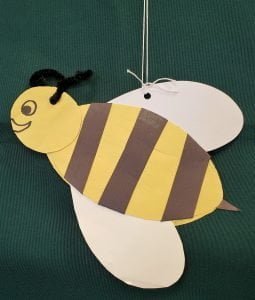 Directions:
Directions:
- Take one yellow body piece and glue two wings on (one one the top and the bottom of the body)
- Glue another yellow body piece onto the other, so that the place where the wings are glued on is covered up.
- Glue one circular head piece on one end of the body.
- Hole punch a hole on the top of the head piece. Put a small pipe cleaner through the hole, twist so that the ends make a “V” shape, and continue bending into desired antenna form.
- Hole punch one wing and tie a string through it, so children can carry it away and make their bees fly.
- Decorate, decorate, decorate! Get creative with your stripes and faces! But don’t forget to decorate both sides. You can add a stinger with some black construction paper.
*Have older children cut out the pieces and make their own version of the bee!
Looking for more garden-related activities? Check out the Growing Minds This Week in the Garden (TWIG) newsletters for the first week of April.
 Poetry in the Garden:
Poetry in the Garden:
Since April is National Poetry Month, today we’re sharing Growing Minds’ Poetry in the Garden lesson plan, which includes two activities. By writing poems that connect with the garden, students will strengthen their creative writing skills.
For the first activity, feel free to sub out a different garden-themed book of your choice if you don’t have The Scarecrow at home. For this activity children will create an acrostic poem–a poem where the letters in each line spell out a word or phrase. If you want to stick with this week’s pollinator theme, acrostic poems could be written using the words BEES, HONEY, FLOWER, HUMMINGBIRD, BUTTERFLY or POLLINATION.
For the second activity, you can use Monday’s poem of the day, “From Bee to Me”, or a poem of your choice to explore the use of white space in poems. Be sure to present the poem to your children in two forms, paragraph and poem. See below for an example.
From Bee to Me [paragraph form]
by Michelle Schaub
Fields of clover with roaming bees, nectar collected busily. Hives abuzz with activity, combs enclosing sweet mystery. Keepers’ smoke calms the jamboree, jars of liquid-gold alchemy. City, market, and (finally) me.
[poem form]
From Bee to Me
By Michelle Schaub
Fields of clover with roaming bees,
nectar collected busily.
Hives abuzz with activity,
combs enclosing sweet mystery.
Keepers’ smoke calms the jamboree,
jars of liquid-gold alchemy.
City,
market,
and (finally)
me.
Visit the Growing Minds’s farm to school literature database and type “poetry” into the search bar to discover more garden-themed children’s poetry books.
—
That’s it for this week. Next week’s Growing Minds Day by Day theme will be Starting a (Local) Garden. Be sure to check back next week for new resources. Click here to access Day by Day resources from past weeks.
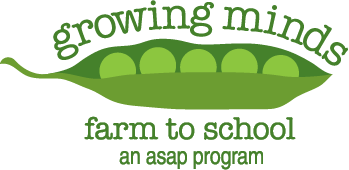
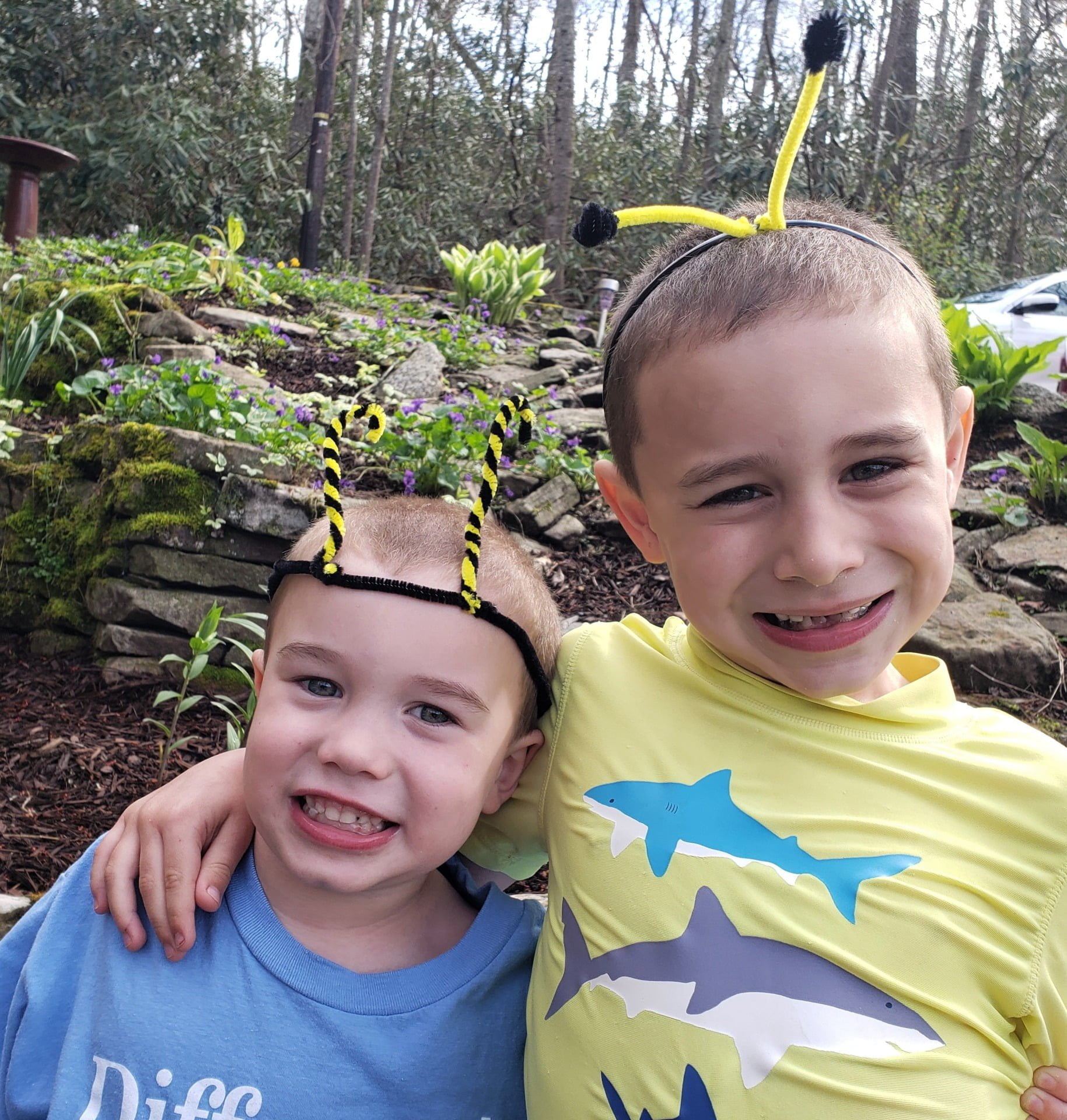
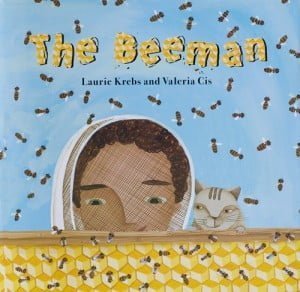 Book:
Book: 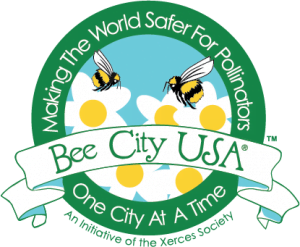 Educational Resources:
Educational Resources: Activities:
Activities: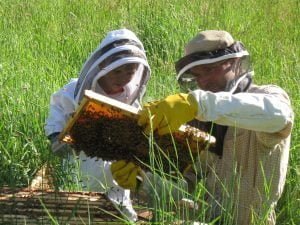 Poetry in the Garden:
Poetry in the Garden: